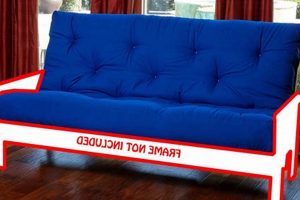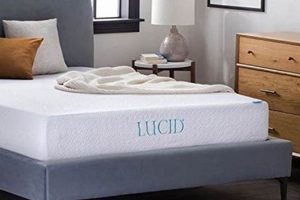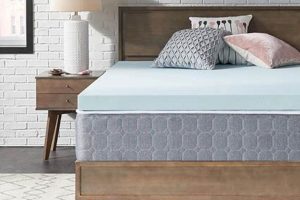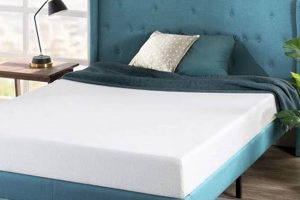The frequency with which one should procure a new viscoelastic foam sleeping surface is a crucial consideration for maintaining optimal sleep hygiene and overall well-being. This decision hinges on factors like usage patterns, material quality, and individual needs, impacting both comfort and health.
Regular replacement is important because it impacts postural support, which degrades over time, leading to potential discomfort and sleep disturbances. Moreover, aging foam can harbor allergens and dust mites, potentially exacerbating respiratory issues. The timeline for replacement represents a balance between the initial investment and the long-term benefits of a supportive and hygienic sleep environment.
Understanding the factors that influence this timeline, recognizing the signs of degradation, and adhering to recommended maintenance practices are essential for maximizing the lifespan and ensuring the continued benefits of this type of sleep surface.
Guidance on Viscoelastic Foam Mattress Replacement Frequency
The lifespan of a viscoelastic foam mattress varies, influencing its support and hygiene. These guidelines assist in determining the optimal point for replacement:
Tip 1: Monitor Support Degradation: Observe the mattress for sagging or indentations, particularly in areas that bear significant weight. Such deformation indicates compromised support.
Tip 2: Assess Comfort Levels: Evaluate if the mattress continues to provide adequate comfort. Persistent aches or restless sleep can signal that it is no longer fulfilling its purpose.
Tip 3: Consider Usage Patterns: A mattress used nightly will likely degrade more rapidly than one in a guest room. Frequency of use is a significant factor.
Tip 4: Evaluate Allergen Buildup: Over time, mattresses accumulate dust mites and allergens. Individuals with sensitivities should consider replacement more frequently.
Tip 5: Review Warranty Terms: Many manufacturers provide warranties addressing premature wear or defects. Consult warranty documentation for guidance.
Tip 6: Examine for Mold or Mildew: Inspect the mattress, especially in humid environments, for signs of mold or mildew growth. Infestation necessitates immediate replacement.
Adhering to these recommendations ensures consistent sleep quality and mitigates potential health concerns associated with aged or damaged mattresses.
Implementing these practices optimizes the investment in sleep and contributes to long-term well-being.
1. Support Degradation
Support degradation in a viscoelastic foam mattress is a primary indicator influencing the replacement schedule. As the foam structure breaks down, its capacity to provide adequate spinal alignment and pressure relief diminishes, directly impacting sleep quality and potentially contributing to musculoskeletal issues.
- Loss of Density and Resilience
Over time, the foam material loses density due to compression and material fatigue. This reduces its ability to spring back to its original shape after pressure is removed, leading to sagging and a lack of uniform support. A mattress exhibiting persistent indentations requires more frequent replacement.
- Compromised Spinal Alignment
Effective support maintains the natural curvature of the spine during sleep. Support degradation results in uneven weight distribution, causing the spine to misalign. This misalignment can manifest as back pain, neck stiffness, and general discomfort, indicating the need for a new mattress.
- Increased Pressure Point Sensitivity
A mattress in good condition evenly distributes body weight, minimizing pressure on sensitive areas like hips and shoulders. As support degrades, pressure points become more pronounced, leading to pain, numbness, and restless sleep. This elevated pressure sensitivity is a clear sign of inadequate support and warrants consideration for mattress replacement.
- Impact on Sleep Quality
Degradation affects the overall sleep experience. Constant tossing and turning, difficulty finding a comfortable position, and waking up feeling unrefreshed are indicators of compromised support. A decline in sleep quality is a significant factor when determining the replacement timeline.
The interconnected nature of these aspects directly correlates with the mattress replacement frequency. A proactive assessment of these elements allows for informed decisions regarding the optimal time to replace the mattress, ensuring continued comfort, adequate support, and the maintenance of healthy sleep patterns.
2. Comfort Decline
A reduction in perceived comfort levels is a significant factor determining the appropriate replacement interval for viscoelastic foam mattresses. Comfort decline manifests as a deviation from the initial supportive and pressure-relieving qualities experienced when the mattress was new. This deterioration directly influences sleep quality and can exacerbate existing physical discomforts.
Several factors contribute to this decline. Over time, the foam material undergoes structural changes due to constant compression, temperature fluctuations, and exposure to humidity. These changes result in a loss of resilience, increased firmness, or uneven surface topography. For example, a mattress that once conformed effectively to the body’s contours may develop localized depressions or become generally harder, leading to increased pressure on prominent body parts such as hips and shoulders. This diminished conformity disrupts natural spinal alignment and increases the likelihood of restless sleep. Individuals who previously experienced restful sleep on their mattress may begin to report waking up feeling stiff, sore, or unrefreshed. Such experiences highlight the practical importance of recognizing and addressing comfort decline as a key determinant of mattress replacement.
The correlation between comfort decline and replacement frequency is intrinsically linked. The longer a person continues to use a mattress exhibiting reduced comfort, the greater the potential for experiencing adverse health effects, including chronic pain, sleep deprivation, and reduced overall well-being. Therefore, consistently monitoring comfort levels and proactively addressing noticeable declines is crucial for optimizing sleep quality and maintaining physical health. Delaying replacement based solely on cost considerations can ultimately lead to increased healthcare expenditures associated with treating conditions exacerbated by inadequate sleep support.
3. Usage Frequency
The frequency with which a viscoelastic foam mattress is utilized is a fundamental determinant in establishing an appropriate replacement schedule. Increased use invariably accelerates the degradation process, necessitating more frequent replacement cycles. Daily use, as opposed to occasional use in a guest room, subjects the foam to constant compression and stress, which leads to a faster breakdown of its structural integrity and supportive capabilities. This direct correlation between utilization rate and material wear is a primary consideration.
For example, a single adult using a mattress daily will likely observe a decline in support and comfort within five to seven years. In contrast, a mattress in a seldom-used guest room might maintain adequate support for upwards of ten years or more. Furthermore, individuals with higher body weights exert greater pressure on the foam, compounding the effects of frequent use and potentially shortening the mattress lifespan considerably. Similarly, the presence of multiple sleepers on the same mattress increases the cumulative pressure, accelerating wear and tear and underscoring the significance of usage patterns in predicting replacement needs.
In conclusion, understanding the relationship between utilization rate and mattress longevity is essential for informed decision-making. Ignoring the impact of frequent use can lead to premature support failure, diminished sleep quality, and potential health complications. By considering the intensity of use, owners can establish a realistic replacement timeline that aligns with the actual performance and condition of the mattress, safeguarding both comfort and well-being.
4. Allergen Accumulation
Allergen accumulation within a viscoelastic foam mattress is a substantial factor influencing the appropriate replacement frequency. Over time, these mattresses become reservoirs for various allergens, including dust mites, pet dander, mold spores, and pollen. This buildup directly affects indoor air quality and can exacerbate allergic reactions and respiratory ailments in susceptible individuals. The porous nature of the foam creates an ideal environment for allergen proliferation, making regular replacement a critical preventative measure.
The effect of allergen accumulation extends beyond mere discomfort. Chronic exposure to these irritants can lead to persistent allergy symptoms such as sneezing, coughing, itchy eyes, and skin rashes. In more severe cases, it can trigger asthma attacks or contribute to the development of other respiratory conditions. Traditional cleaning methods often prove inadequate in removing deeply embedded allergens, highlighting the limitations of surface-level interventions. Regular replacement of the mattress becomes a more effective strategy to mitigate allergen exposure, particularly for those with known sensitivities or compromised immune systems. This is illustrated by instances where individuals experiencing persistent allergic symptoms find significant relief only after replacing an older mattress suspected of harboring substantial allergen loads. The correlation, therefore, between allergen levels and health outcomes underscores the importance of considering this factor when determining mattress replacement frequency.
In conclusion, the accumulation of allergens within a mattress directly impacts sleep quality and overall health, particularly for vulnerable populations. While protective measures such as mattress encasements and regular vacuuming can help minimize allergen buildup, they do not eliminate the need for eventual replacement. Integrating an awareness of allergen-related health risks into the decision-making process regarding mattress replacement frequency is essential for maintaining a healthy sleep environment and mitigating potential adverse health outcomes. The practical significance of this understanding lies in its potential to improve sleep quality, reduce allergy symptoms, and enhance overall well-being.
5. Warranty Duration
Warranty duration serves as an initial benchmark when considering the replacement timeline for a viscoelastic foam mattress. While not a definitive indicator of lifespan, it provides a manufacturer’s assessment of the expected minimum period of performance under normal usage conditions.
- Coverage Scope and Limitations
Mattress warranties typically cover manufacturing defects and premature sagging exceeding a specified threshold (e.g., 1.5 inches). However, they often exclude damage resulting from misuse, stains, or normal wear and tear. Understanding these limitations is crucial, as a warranty claim may be denied even if the mattress is within the coverage period but exhibits damage outside the scope of the warranty. The presence of covered defects might necessitate replacement sooner than anticipated, irrespective of the mattress’s age.
- Pro-rated vs. Non-pro-rated Coverage
Some warranties are pro-rated, meaning the consumer is responsible for a portion of the replacement cost based on the mattress’s age at the time of the claim. Non-pro-rated warranties cover the full replacement cost within the specified period. A pro-rated warranty might incentivize delaying replacement despite declining support, while a non-pro-rated warranty encourages addressing issues promptly to maximize the warranty benefit. This financial aspect influences the replacement decision.
- Manufacturer’s Expected Lifespan Indicator
The duration of the warranty, even if not fully indicative of actual lifespan, reflects the manufacturer’s confidence in the product’s durability. A longer warranty period suggests a higher expectation of longevity under standard conditions. Conversely, a shorter warranty might signal a lower expected lifespan. While individual experiences may vary, the warranty duration provides a relative benchmark for anticipated performance.
- Correlation with Material Quality
Generally, mattresses constructed with higher-density foam and superior materials tend to have longer warranty periods. The warranty often reflects the manufacturer’s assessment of the materials’ resistance to degradation over time. Therefore, a longer warranty may indirectly correlate with a potentially longer usable lifespan, provided that other factors, such as usage patterns and environmental conditions, are favorable.
While warranty duration offers a valuable initial perspective, it is imperative to consider it in conjunction with other factors, such as observed support degradation, comfort decline, and hygiene concerns, when determining the optimal time to replace a viscoelastic foam mattress. Relying solely on the warranty period may lead to delayed replacement, compromising sleep quality and potentially impacting health.
6. Mold/Mildew Risk
The risk of mold and mildew growth within a viscoelastic foam mattress significantly influences the recommended replacement frequency. These microorganisms thrive in damp, poorly ventilated environments, commonly found within the dense structure of such mattresses. Proactive assessment and mitigation are essential to maintaining a hyg
ienic sleep environment.
- Humidity and Ventilation
Elevated humidity levels, coupled with inadequate ventilation, create conducive conditions for mold and mildew proliferation. Mattresses located in humid climates or on platforms lacking airflow are particularly susceptible. Regular monitoring of humidity levels in the sleeping area and employing methods to improve ventilation can mitigate this risk, though eventual replacement remains necessary.
- Moisture Intrusion
Spilled liquids, sweat, and inadequate drying after cleaning can introduce moisture into the mattress core. This moisture provides a breeding ground for mold and mildew. Prompt and thorough drying after any liquid exposure is crucial, but repeated incidents can lead to deep-seated contamination requiring premature replacement.
- Health Implications
Exposure to mold and mildew spores can trigger allergic reactions, respiratory problems, and other adverse health effects. Individuals with pre-existing respiratory conditions are particularly vulnerable. The presence of visible mold or a musty odor emanating from the mattress necessitates immediate replacement, regardless of its age.
- Material Degradation
Mold and mildew not only pose health risks but also contribute to the degradation of the foam material itself. These microorganisms can break down the foam structure, compromising its support and comfort. Evidence of material deterioration due to microbial activity accelerates the need for replacement.
The interrelationship between mold/mildew risk and replacement frequency is direct and consequential. While preventative measures can extend the lifespan, vigilance and proactive assessment are essential. The presence of conditions conducive to microbial growth necessitates more frequent inspection and, ultimately, replacement to safeguard health and maintain a hygienic sleep environment.
Frequently Asked Questions
The following section addresses common inquiries concerning the appropriate replacement intervals for viscoelastic foam mattresses, providing clarity and guidance on this critical aspect of sleep hygiene.
Question 1: What is the generally recommended replacement timeframe for a viscoelastic foam mattress?
The consensus suggests replacing these mattresses every seven to ten years, contingent upon factors such as usage patterns, material quality, and individual health considerations.
Question 2: What are the key indicators that a viscoelastic foam mattress requires replacement?
Significant indicators include visible sagging, persistent discomfort, increased allergen sensitivity, and the presence of mold or mildew. A decline in sleep quality despite consistent sleep routines also warrants evaluation.
Question 3: Does the density of the foam affect the replacement frequency?
Higher-density foam generally exhibits greater durability and resilience, potentially extending the mattress lifespan. Lower-density foam tends to degrade more rapidly, necessitating more frequent replacement.
Question 4: How does body weight impact the lifespan and replacement frequency?
Individuals with higher body weights exert greater pressure on the mattress, accelerating wear and tear. This increased pressure may necessitate more frequent replacement to maintain adequate support and comfort.
Question 5: Can mattress protectors extend the lifespan of a viscoelastic foam mattress?
Mattress protectors can mitigate allergen accumulation, prevent staining, and reduce wear from friction. However, they do not prevent eventual foam degradation and the need for replacement.
Question 6: Is professional cleaning a viable alternative to mattress replacement?
Professional cleaning can remove surface-level allergens and stains but cannot restore lost support or address deep-seated mold/mildew issues. It is not a substitute for eventual replacement.
In summary, a multi-faceted approach considering these factors is crucial for determining the optimal replacement timeline. Routine assessment and proactive maintenance are essential for maximizing mattress lifespan and ensuring continued sleep quality.
Understanding maintenance practices for viscoelastic foam mattresses can further extend their usability and preserve their qualities. The subsequent section details these practices.
Conclusion
The preceding exploration highlights the multifaceted nature of determining the appropriate replacement frequency for a viscoelastic foam mattress. The decision involves careful consideration of factors ranging from material degradation and usage patterns to health concerns related to allergen accumulation and microbial growth. A reliance solely on warranty duration is insufficient; a proactive and informed approach, encompassing regular assessment of support, comfort, and hygiene, is paramount.
Ultimately, the optimization of sleep quality and the safeguarding of long-term health necessitate a commitment to timely mattress replacement. Individuals are encouraged to apply the knowledge presented herein to establish a replacement schedule that aligns with their unique circumstances, ensuring a consistently supportive and hygienic sleep environment. Prioritizing this aspect of personal well-being represents an investment in both immediate comfort and enduring health outcomes.







